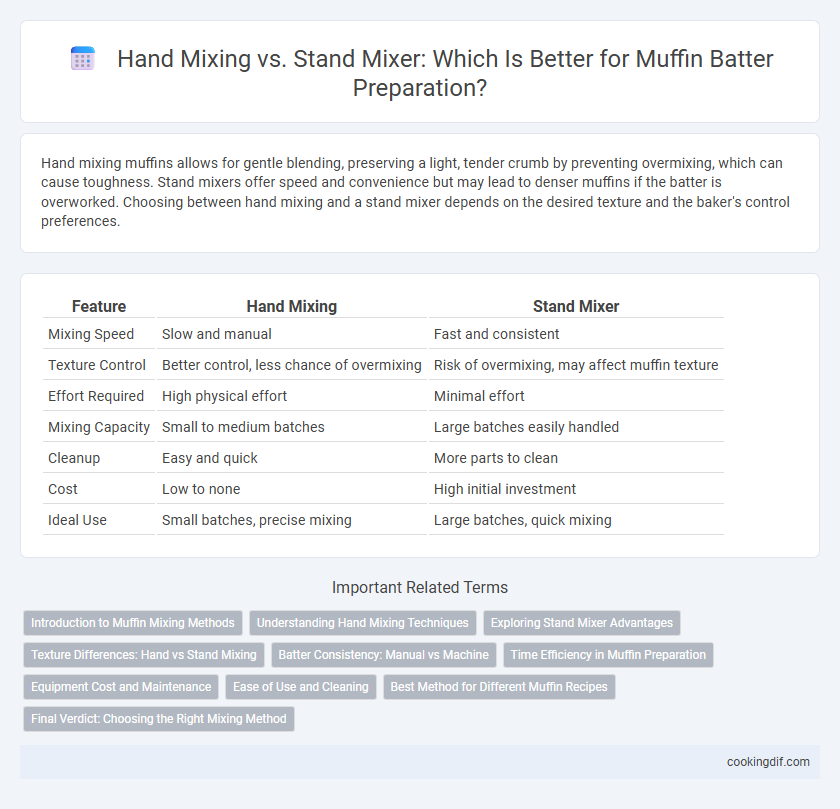Hand mixing muffins allows for gentle blending, preserving a light, tender crumb by preventing overmixing, which can cause toughness. Stand mixers offer speed and convenience but may lead to denser muffins if the batter is overworked. Choosing between hand mixing and a stand mixer depends on the desired texture and the baker's control preferences.
Table of Comparison
| Feature | Hand Mixing | Stand Mixer |
|---|---|---|
| Mixing Speed | Slow and manual | Fast and consistent |
| Texture Control | Better control, less chance of overmixing | Risk of overmixing, may affect muffin texture |
| Effort Required | High physical effort | Minimal effort |
| Mixing Capacity | Small to medium batches | Large batches easily handled |
| Cleanup | Easy and quick | More parts to clean |
| Cost | Low to none | High initial investment |
| Ideal Use | Small batches, precise mixing | Large batches, quick mixing |
Introduction to Muffin Mixing Methods
Hand mixing muffins preserves a tender crumb by allowing more control over mixing speed and preventing overdevelopment of gluten, which can result in dense texture. Stand mixers offer efficiency and consistency by blending ingredients quickly and uniformly, suitable for higher volume baking without compromising texture when used with proper technique. Choosing the optimal method depends on balancing texture preferences with batch size and equipment availability for perfect muffin results.
Understanding Hand Mixing Techniques
Hand mixing muffins allows greater control over batter consistency, preventing overmixing that can cause tough, dense muffins. Using a wooden spoon or spatula, gently fold dry ingredients into wet ingredients just until combined to maintain a tender crumb. Mastering hand mixing techniques ensures light, fluffy muffins with optimal texture and even rise.
Exploring Stand Mixer Advantages
Using a stand mixer for muffin mixing significantly improves consistency by evenly blending ingredients, resulting in a uniform batter texture. Stand mixers save time and reduce physical effort compared to hand mixing, allowing for quicker preparation, especially when dealing with multiple batches. These devices also provide precise speed control and powerful motor performance, ensuring optimal mixing without overworking the batter, which helps maintain the muffins' tender crumb.
Texture Differences: Hand vs Stand Mixing
Hand mixing muffins results in a coarser, denser texture due to variable mixing speed and less aeration. Stand mixers incorporate more air into the batter, producing lighter, fluffier muffins with a more uniform crumb. Overmixing with a stand mixer can lead to tough, chewy muffins by developing excess gluten.
Batter Consistency: Manual vs Machine
Hand mixing muffin batter often results in a slightly uneven consistency with occasional lumps, which can lead to a denser texture in the final baked product. Stand mixers provide a more uniform batter by thoroughly combining ingredients, improving aeration and creating a lighter, fluffier muffin crumb. Consistent mixing speed and power from stand mixers reduce the risk of overmixing, preserving desired batter structure for optimal muffin rise.
Time Efficiency in Muffin Preparation
Hand mixing muffins typically requires 5 to 10 minutes, relying on manual effort that can lead to inconsistent batter texture and longer preparation time. Stand mixers reduce mixing time to about 2 to 3 minutes, delivering smooth, evenly mixed batter that improves muffin crumb and rise consistency. Time efficiency gained from stand mixers enhances overall baking productivity, especially in high-volume muffin production.
Equipment Cost and Maintenance
Hand mixing muffins requires minimal equipment cost, typically just a whisk or spoon, and involves low maintenance with no mechanical parts to service. Stand mixers represent a higher initial investment, ranging from $100 to $500, and incur maintenance costs such as motor upkeep and occasional part replacements. Choosing hand mixing lowers expenses but demands more manual effort, while stand mixers offer efficiency at a higher cost and maintenance commitment.
Ease of Use and Cleaning
Hand mixing muffins offers greater control over batter consistency and reduces the risk of overmixing, making it ideal for delicate recipes, while allowing for quick cleanup with just a bowl and whisk. Stand mixers provide effortless blending and save time, especially for large batches, but their multiple attachments and heavy parts require more thorough cleaning and maintenance. Choosing between them depends on prioritizing hands-on ease and minimal cleaning or efficiency and power at the cost of extended cleanup.
Best Method for Different Muffin Recipes
Hand mixing allows gentler incorporation of ingredients, ideal for tender muffins like blueberry or bran that benefit from minimal gluten development. Stand mixers provide consistent, rapid mixing suited for denser muffin varieties such as chocolate or banana nut, ensuring even distribution of mix-ins and aeration. Choosing the best method depends on the muffin recipe's texture goals and ingredient sensitivity, with hand mixing preferred for delicate batters and stand mixers for hearty, thicker doughs.
Final Verdict: Choosing the Right Mixing Method
Hand mixing muffins offers greater control over batter texture, reducing the risk of overmixing and resulting in tender, moist crumb structures. Stand mixers provide speed and convenience, ensuring consistent ingredient incorporation but may lead to tougher muffins if overworked. For optimal muffin quality, hand mixing is preferred when aiming for delicate texture, while stand mixers suit large batches requiring efficiency.
Hand mixing vs Stand mixer for muffin mixing Infographic

 cookingdif.com
cookingdif.com